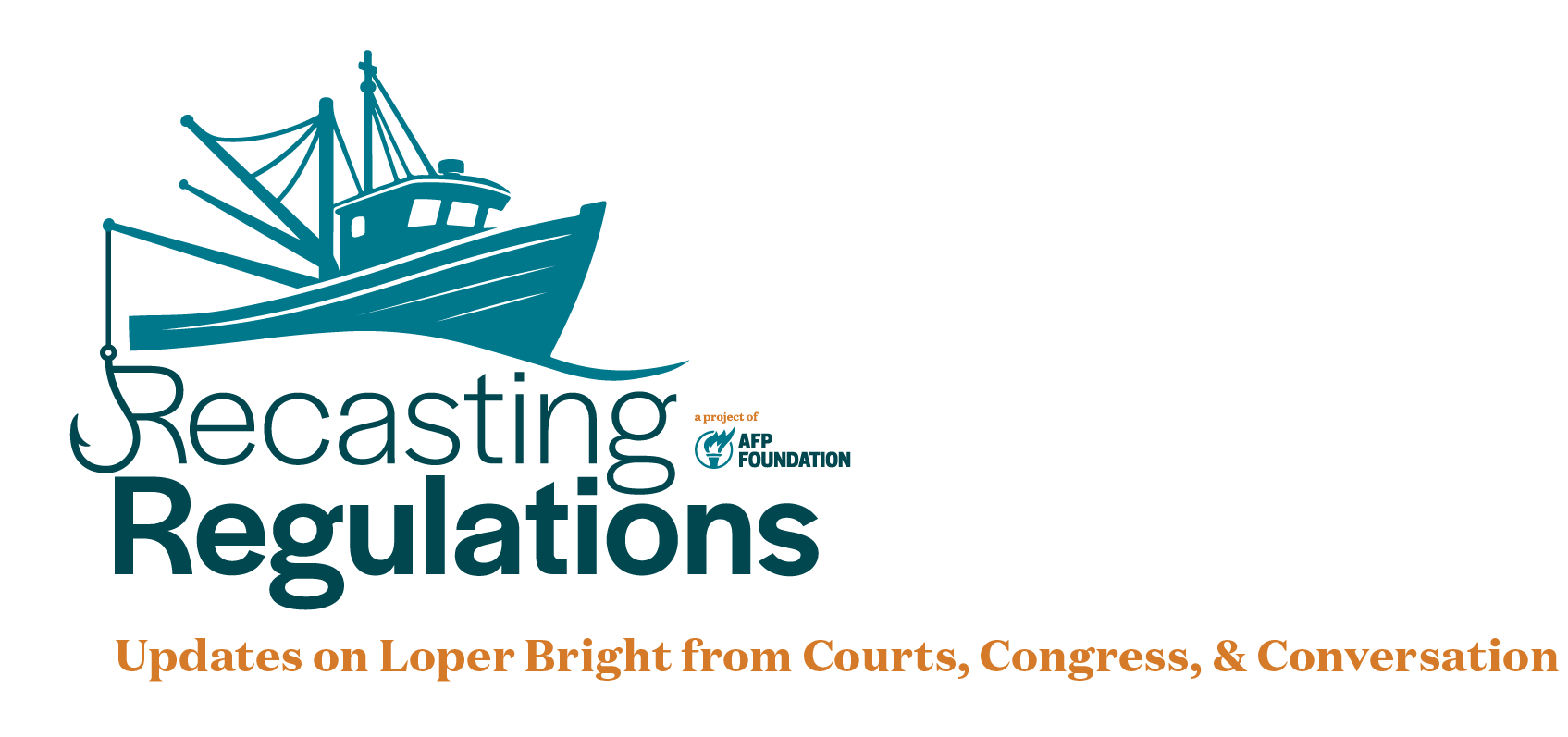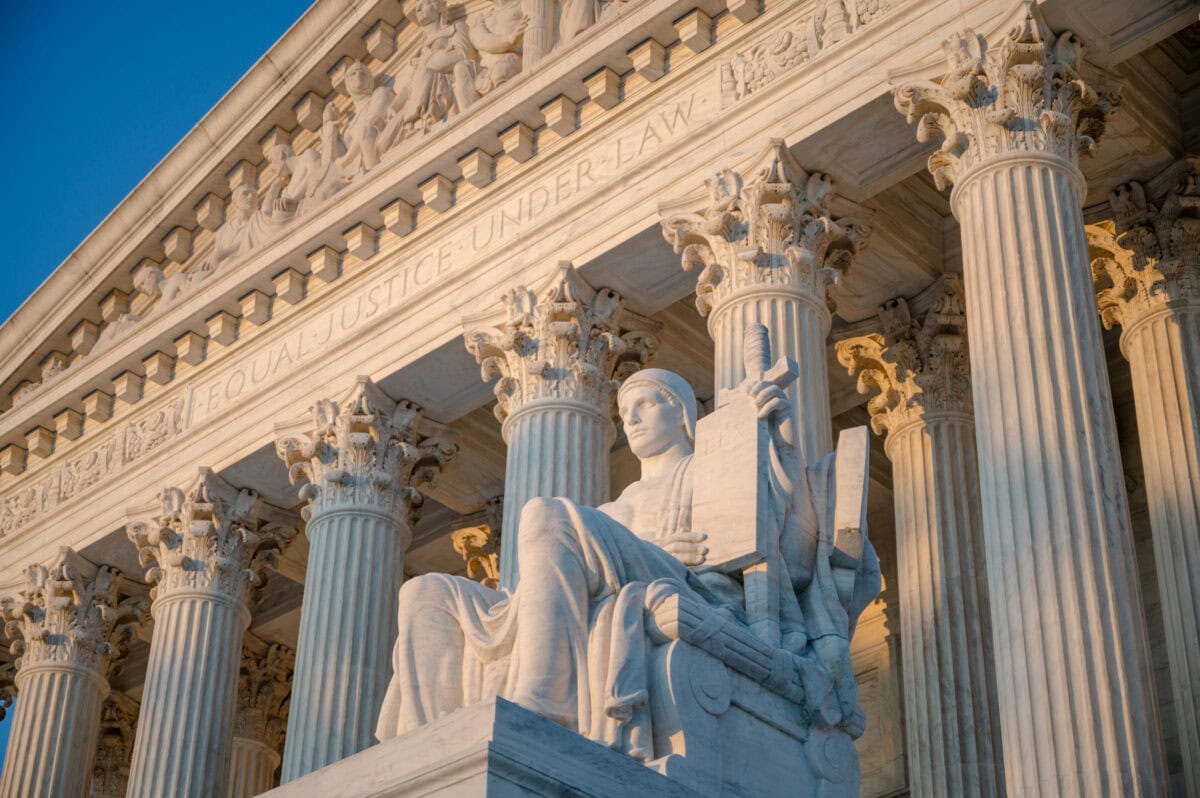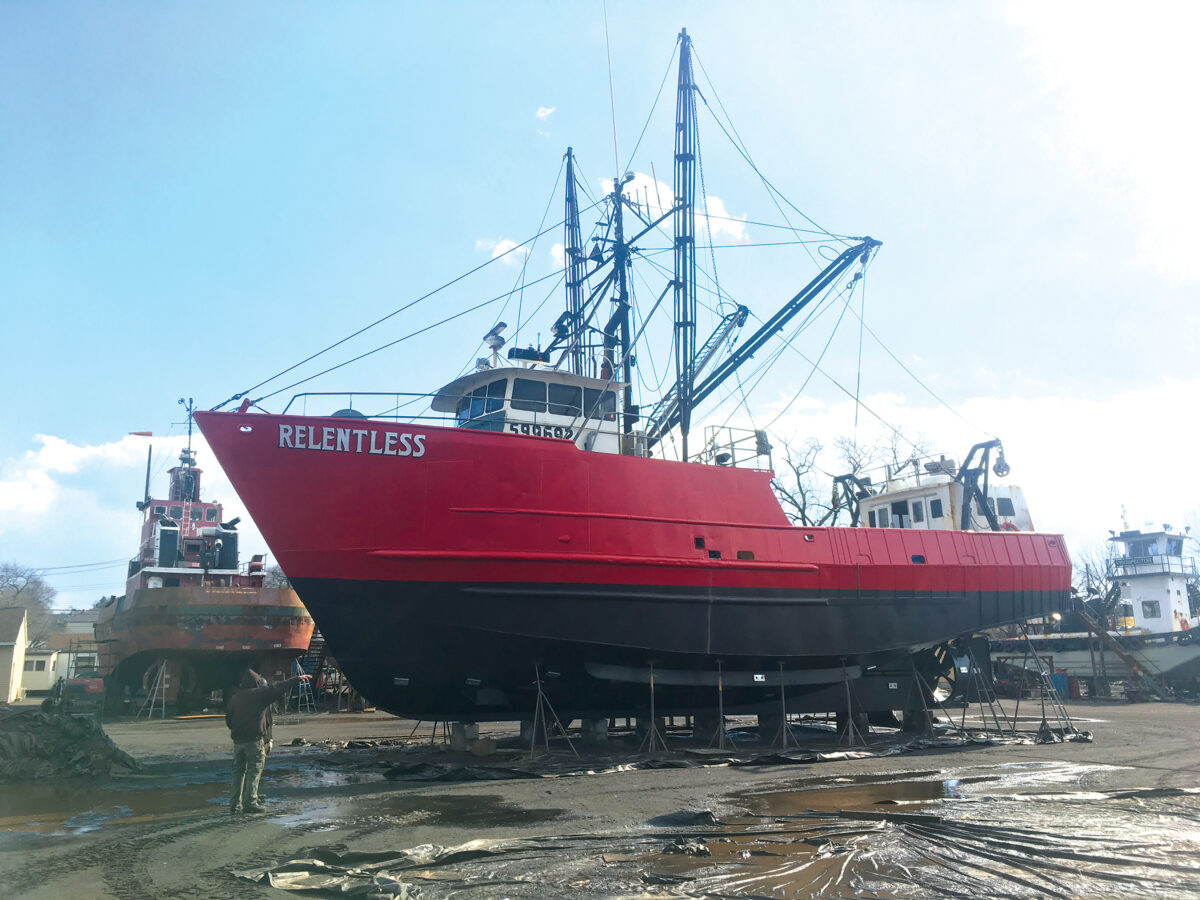
Subscribe to Recasting Regulations to Sign up for Loper Bright Updates.
"*" indicates required fields
Following her appearance at the HSGAC hearing on the future of Loper Bright, former OIRA Administrator Susan Dudley had a series of recommendations for how Congress can reassert itself and fulfill its constitutional role.
“First, legislation should recognize that while scientific facts are a necessary element of good policy design, they are almost never sufficient.”
“Second, Congress should provide agencies with clear guidance on how they should weigh competing considerations.”
“Third, … Congress should require agencies to evaluate their regulations periodically to determine how effective they are at achieving legislative goals, and to identify needed revisions both to the regulations and the underlying statutory authority.”
“Fourth, to support these efforts, Congress itself needs more resources[.]”
On July 23rd, in Zimmer Radio of Mid-Missouri v. FCC, the Eighth Circuit applied the Supreme Court’s decision in Loper Bright to a dispute over the FCC’s quadrennial review of its media ownership rules in a way that highlights a few key themes in Loper Bright statutory interpretation cases.
- Courts generally review an agency’s interpretation of a statute (a legal question) de novo, independently fixing the metes and bounds of the agency’s power and discretion using traditional canons of interpretation.
- An agency’s contemporaneous and longstanding interpretation may shed light on a statute’s best reading.
- Subject to constitutional limits, where a statute is best read to delegate discretion to an agency, how the agency exercises that discretion under the deferential arbitrary and capricious standard so long as the agency stays within the boundaries set by the statute, particularly for agency decisions that turn on factual findings, policy decisions, and/or implicate technical expertise.
Background on the FCC Order
Under Section 202(h) of the Telecommunications Act of 1996, every four years the FCC is statutorily required to review its rules. Congress instructed that, as part of that review, the FCC “shall determine whether any of such rules are necessary in the public interest as the result of competition” and “shall repeal or modify any regulation it determines to be no longer in the public interest.” After conducting its 2018 review, the FCC decided to keep all of those rules on the books and tighten one of them. Petitioners challenged the FCC’s 2023 Order on multiple grounds, some of which elucidate Loper Bright’s impact.
Eighth Circuit Decision on Agency Discretion
In rejecting the petitioners’ argument that the FCC’s 2023 Order’s narrow definition of “market” was inconsistent with Section 202(h), the Eighth Circuit read Loper Bright to, on the one hand, require courts to rigorously police the boundaries of an agency’s statutory authority and independently decide what the law is. But the Court also cited Loper Bright for the proposition that Congress often writes laws “intentionally [to] provide agencies with discretion.” And as Loper Bright teaches, “[w]hen the best reading of a statute is that it delegates discretionary authority to an agency,” the APA requires courts “to independently interpret the statute and effectuate the will of Congress subject to constitutional limits.”
Applying these principles, the Eighth Circuit found that Section 202(h) is one such law, concluding that given the FCC’s “broad power to regulate in the public interest,” the agency “is best positioned to define ‘competition’ for purposes of Section 202(h).” The Court also invoked Loper Bright’s teaching that an agency’s contemporaneous and consistent interpretation can be evidence of a statute’s meaning as further supporting the FCC’s exercise of discretion to define “competition” for purposes of Section 202(h). As the Eighth Circuit put it, “[t]he Section 202(h) dispute here deals not with the meaning of competition, but with the degree—how much competition must be considered in analyzing the ownership rules subject to Section 202(h) review. . . . In essence, the question is one of line drawing.” Thus, while the FCC had to consider competition in its quadrennial review, it had discretion to decide how broad or narrow the relevant markets are. The Court framed that as a technical, policy-laden decision that Congress may delegate.
The Court next addressed petitioners’ alternative argument that the FCC’s market definition was arbitrary and capricious. Quoting the Supreme Court’s recent decision in Seven County Infrastructure Coalition v. Eagle County, Colorado (a case which may further elucidate Loper Bright’s meaning), the Court also noted “[w]hile judicial review of an agency’s statutory interpretation is generally de novo, ‘when an agency exercises discretion . . . , judicial review is typically conducted under the Administrative Procedure Act’s deferential arbitrary-and-capricious standard.’” Applying this deferential standard, the Court “decline[d] to second-guess the FCC’s market definitions,” later noting that it was not judicial role to determine what decision the agency should have reached.
The Court decided another statutory authority question in petitioners’ favor, quoting Loper Bright to reiterate that “[i]n evaluating the Section 202(h) challenge, we ‘must exercise [our] independent judgment in deciding whether [the FCC] has acted within its statutory authority.’” Petitioners argued that a provision of the 2023 Order that expanded a regulation exceeded the FCC’s authority under Section 202(h). The Court agreed. Again independently interpreting Section 202(h) to fix the bounds of the FCC’s authority, the Court concluded that it “provides for a two-step process. First, the Commission determines whether any of the regulations subject to review are necessary in the public interest as the result of competition. If the rules are no longer necessary, the Commission has two choices: repeal or modify.” Those choices are binary. By contrast, “[i]f the rules remain necessary in the public interest, . . . the inquiry and the FCC’s authority end.” In that case, the rule must remain in its current form unchanged. In other words, while Section 202(h) grants the FCC broad discretion in some areas, it is a one-way deregulatory ratchet that cannot be used to tighten regulations already on the books. The Court also rejected the FCC’s interpretation of “modify” to include the power to tighten regulations, using traditional tools of statutory construction. Based on that statutory interpretation, the Court found that the FCC’s decision to tighten a regulation it deemed “necessary in the public interest” was ultra vires.
The Eighth Circuit’s thoughtful decision in Zimmer Radio is yet another example of Loper Bright’s continuing and emerging impact on administrative law and statutory interpretation.
Here’s how the Wall Street Journal Editorial Page described the exchange:
Mr. Nixon’s tariffs for the most part also didn’t exceed the tariff “schedule that had already been enacted,” said another judge. Mr. Trump’s do. Mr. Shumate’s fall-back was that IEEPA was meant to be interpreted “very broadly.” But “is that really how we interpret statutes anymore?” and “do you think that standard survives Loper Bright?” judges asked.
The High Court’s Loper Bright (2024) landmark says that judges shouldn’t automatically defer to regulators’ interpretations of vague laws. The Court’s major questions doctrine also holds that Congress must give the President express authority for actions with economic and political significance. Mr. Shumate said neither precedent applies to a President’s power to conduct foreign policy.
Video below starts from the beginning of the exchange on Loper. Full oral argument audio here.
The first several months of the Trump Administration have focused on executive orders, agency reorganization, and budget reconciliation. But attention is now shifting to the meat of Executive Branch reform: deregulation. The Washington Post reports that DOGE has built a deregulatory tool that harnesses AI to assist agencies in identifying and eliminating unnecessary or unlawful regulations.
The July 1st DOGE presentation, obtained by the Post, highlights the AI tools and cites Loper Bright and Executive Order 14,219 as the basis for agencies to identify rules as exceeding statutory authorization. Any deregulatory effort will likely face swift legal challenge under the Administrative Procedure Act. And the novel use of AI tools is sure to raise a host of new legal questions.
Courts often examine deregulatory efforts for reasoned decision making under an arbitrary-and-capricious standard of review. The DOGE presentation repeatedly references the importance of agency policy staff and attorneys being intimately involved with the decision-making process. DOGE asserts the tool “enables agencies to comment and modify” the results, while it “automatically drafts all submission documents for attorneys to edit.” Yet the “policy and legal teams [must] make all the decisions.” This is a sage warning, but will agencies heed it in practice? And how will courts react while analyzing the AI-driven processes behind particular deregulatory efforts?
One efficiency the tool boasts is the ability to “analyze & respond to 100,000+ [public regulatory] comments” in a fraction of the time it would take a staffer. But this raises the question, will such review, summary, and response drafted by an AI tool and then later reviewed by a staffer meet the APA’s requirement that agencies give meaningful consideration to commenters’ filings?
And how will agency staff and courts deal with so-called hallucinations. Stories continue to proliferate about courts themselves issuing opinions that contain errors seemingly provided by AI drafters. Presumably these drafts were reviewed and given the judge’s stamp of approval before being issued. Once mistakes were identified, courts pulled them back and corrected the errors. But the federal rulemaking process is not so amenable to post hoc revisions on the fly. Agencies are usually stuck with the reasoning and administrative record they publish along with a final rule. And it is certainly foreseeable that a court would find an error-laden final rule to be arbitrary and capricious, even if the error is a minor one that is easily corrected.
While the use of AI in federal rulemaking raises novel legal questions, using it to comb through the Code of Federal Regulations has enormous potential to identify areas of duplication or deviation from statutory mandates. The sheer scale of an overgrown regulatory state not only burdens the regulated community but it also hampers a reform-minded administration’s ability to assess where changes are most needed or mandated by changes in law. An AI tool is perfectly situated to help sift through such large amounts of data and pinpoint places where agency staff should focus their efforts. New tools always require experimentation, refinement, and redeployment. The use of AI in federal rulemaking will be no different. But it’s heartening to see the Trump Administration’s willingness to experiment with something new.
The Brookings Institution hosted an essay by two professors, Raquel Muñiz and Rebecca Natow, profiling Loper Bright‘s impact on education law. They write:
Since the case was decided in 2024, Loper has been cited by courts as justification to restrain executive agency actions relating to education. In Tennessee v. Cardona (2025), a federal district court in Kentucky cited Loper to state that the court would employ “its independent judgment in interpreting Title IX,” before holding that a Department of Education regulation “impermissibly redefine[d] discrimination on the basis of sex for purposes of Title IX” and “must be set aside.” In Missouri v. Trump (2025) (previously Missouri v. Biden), the Eighth Circuit Court of Appeals barred the Department of Education from canceling student loans under the Saving on a Valuable Education (SAVE) program. In its opinion, the Eighth Circuit cited Loper to state that an executive agency’s interpretation of a statute should receive “respect” but “not supersede” a court’s interpretation.
Read the full essay here.
NRO’s Dan McLaughlin on the recent DOJ filing asking the D.C. Circuit to hold Loper Bright in abeyance on remand while the parties pursue settlement:
The Loper Bright and Relentless plaintiffs could still have a long voyage ahead in the appeals courts — unless the government listens to reason. But it seems that attention to the anomalous position taken by the DOJ and Commerce may be paying off: The government has entered into talks with the Loper Bright plaintiffs to settle the case, and any such settlement would necessarily entail at least some retreat from the original regulations.
The Seventh Circuit has rejected an argument that Loper Bright impacts its standard of appellate review under the Freedom of Information Act (“FOIA”). In Brodsky v. FBI—a case involving a confidential informant’s access to records about himself—the Seventh Circuit affirmed the lower court’s ruling that the FBI properly withheld material under Exemptions 3, 6, and 7, as well as appropriately refused to confirm or deny the existence of responsive records—a so-called “Glomar response.”
As part of his argument on appeal, the informant, Mr. Brodsky, insisted the elimination of Chevron deference foreclosed the Seventh Circuit’s “bifurcated standard of review,” as well as the weight it gives to declarations made by agency officials in FOIA cases. The Circuit rejected that argument, explaining Loper Bright had no bearing on deference to agency factual determinations on appeal.

Although the FOIA is part of the Administrative Procedure Act (“APA”), it has its own standard-of-review provision that requires a district court to review any “matter de novo.” 5 U.S.C. § 552(a)(4)(B). Still, courts routinely afford agency declarations a presumption of good faith and, given the asymmetric distribution of knowledge between an agency and a requester about the content and character of responsive records, it can be difficult for a requester to challenge an agency’s factual claims. More disturbingly, the presumption of good faith often morphs into “substantial deference” in the context of withholding under Exemptions 1 or 3 whenever national-security interests are implicated. Such informal “deference,” as some have argued (here and here), undermines the FOIA’s promise of de novo review.
As a strictly textual matter, the FOIA’s de novo review standard only applies in the district court. The courts of appeal have not uniformly adopted a de novo standard for their review of lower courts’ FOIA decisions. While nearly all of them have, the Third and Seventh Circuits have taken a different approach. In the Seventh Circuit, for example, the appellate court will examine de novo whether the lower court had an adequate factual basis to issue a legally sound ruling. But then it applies a “clear error” standard to assess whether a record has, in fact, been properly withheld or redacted.
Such bifurcated review is odd. It is based on a defensible but highly idiosyncratic reading of the FOIA. But it also does not transgress the principles underlying Loper Bright. (Read my piece on Loper Bright and Exemption 3 for more about how it will impact FOIA jurisprudence.) The Seventh Circuit’s decision in Brodsky has given no indication that the court would defer to a lower court, let alone an agency, on any question of law. That kind of deference would be problematic. Read the Brodsky decision here.
Earlier this week at SCOTUSblog, Columbia University law professor Abbe Gluck suggested the Supreme Court’s recent opinion in Kennedy v. Braidwood Management might reflect what some have forecast as a “revival” of so-called “Skidmore deference.” On her reading of Kennedy, the Court’s examination of “considered and consistent Executive Branch practice—which beg[ins] contemporaneously with enactment of [a] statute”—should not only play an essential role for judges offering their independent judgment as to the best meaning of the law, as required by Loper Bright, but also hints at a reinvigoration of the deference—or “weight”—given to agency legal interpretations under Skidmore v. Swift & Co.
Although Professor Gluck is right to highlight Justice Kavanaugh’s emphasis on the utility of longstanding and consistent agency interpretations, it would be wrong to see such emphasis as a revival of Skidmore, let alone any other type of special solicitude for the views of agency “experts.” The Kennedy decision—along with other cases this term like McLaughlin Chiropractic and VanDerStok—is best understood as part of the Supreme Court’s efforts in the wake of Loper Bright to revitalize the traditional canons of statutory interpretation. Those canons, which play a vital role in the judicial act, long predate Chevron, Skidmore, or the modern administrative state.
Loper Bright and “Respect” for Agency Interpretations
Loper Bright Enterprises v. Raimondo stands for the simple proposition that federal judges must exercise independent judgment to provide their best reading as to the meaning of the law. Judges have various tools at their disposal to reach that best reading. Foremost among them are the canons of statutory construction. These are the rules of the road for how judges interpret legal texts while sticking to “lawfinding rather than lawmaking,” as Justice Gorsuch wrote in his Loper Bright concurrence.
Even though Loper Bright eliminated Chevron’s command to defer to an agency’s legal interpretation in a case of statutory ambiguity, it left room for judges to afford “due respect” to the views of the Executive Branch when trying to discern the meaning of an obscure or difficult term or phrase. As the court explained, “due respect” to an agency’s construction of the law can prove useful for resolving such obscurity, especially if an agency “interpretation was issued roughly contemporaneously with enactment of the statute” at issue and has “remained consistent over time.” Such respect might also be appropriate when an agency’s views are based on “factual premises” within its technical “expertise.” Yet the Loper Bright court made clear that “respect” never entails displacement of a court’s own best judgment. “Due respect” is not equivalent to the deference previously afforded to agencies under Chevron.
What about Skidmore?
At various points in its discussion of “respect” for agency legal interpretations, the Loper Bright majority cited an important administrative law case from the 1940s: Skidmore v. Swift & Co. In Skidmore, the Supreme Court identified several factors that counsel in favor of judges giving agency interpretations “weight” when deciding questions of law. Specifically, the Skidmore court explained agency “interpretations and opinions,” when “made in pursuance of official duty” and “based upon . . . specialized experience,” “constitute[] a body of experience and informed judgment to which courts . . . [can] properly resort for guidance.” The force of those interpretations, in turn, depends on “the thoroughness evident in [the agency’s] consideration [of the issue at hand], the validity of its reasoning, its consistency with earlier and later pronouncements, and all those factors which give it power to persuade, if lacking power to control.” Although the Court may not have intended Skidmore to function as a deference doctrine, in many cases the “power to persuade” tended towards a real power to control.
But what does that all mean now? The Loper Bright court’s repeated references to Skidmore, without any obvious unpacking of what that “deference” looks like after Chevron, may seem to verge on the irresponsible. It certainly fueled academic curiosity, with scholars like Professors Kristin Hickman and Bernard Bell considering how courts might revitalize or expand Skidmore’s domain.
But it is hard to square a robust neo-Skidmore-deference doctrine with the overall thrust of Loper Bright. Every reference to Skidmore (save one) in Loper Bright is accompanied by a reiteration of the importance of the longstanding and contemporaneous qualities of an agency’s interpretation. None of the other Skidmore factors, such as procedural rigor or internal logic, are mentioned. That likely reveals the Loper Bright court’s intent to reign-in and limit any revival of Skidmore, or perhaps even to redefine it for the post-Chevron age. Judge Kavanaugh’s comments during the Loper Bright oral argument are telling, in this regard, especially as he wrote the opinion in Kennedy.

Justice Kavanaugh’s narrow reading of Skidmore stands in stark contrast to the aggressive version found in United States v. Mead Corp. There, Justice Souter enumerated a host of factors that might trigger a “fair measure of deference” to an agency whenever a question arises over the meaning “its own statute,” such as the “degree of the agency’s care, its consistency, formality, and relative expertness.” Justice Scalia, in dissent, castigated this approach as ill-defined, especially as to the level of deference actually afforded to an agency. Skidmore, as refined by Mead, was akin to “that test most beloved by a court unwilling to be held to the rules (and most feared by litigants who want to know what to expect): th’ol ‘totality of the circumstances’ test.” This criticism holds true today. A resurrected totality-of-the-circumstances Skidmore that functions just like Chevron would be “a recipe for uncertainty, unpredictability, and endless litigation.”
The October 2024 Term—Whither Skidmore?
This brings us to the Court’s recently completed term. Does Kennedy represent a meaningful revival of Skidmore? The evidence would suggest not.
To begin with, the Supreme Court has not once cited Skidmore since Loper Bright was decided. It would be curious indeed if the Court intended to leave the door open to neo-Skidmore deference, but without any citation to the seminal decision. Similarly, it is hard to countenance how “due respect” could translate to a revitalized deference regime after the Court’s explicit clarification in Seven County Infrastructure Coalition v. Eagle County that judicial review under Section 706 of the APA really does mean de novo review. The silence of Loper Bright on this point left some pro-Chevron commentators hopeful that Skidmore could serve as a vehicle for reintroducing deference. That seems unlikely at this point.
This term’s decisions instead reflect a decided effort by the Court to stress the basic aspects of statutory construction and to revive traditional interpretive canons. Consider, for example, McLaughlin Chiropractic Associates v. McKesson Corp., which directs courts to “determine the meaning of the law under ordinary principles of statutory interpretation.” To the extent “appropriate respect” is due to an agency’s interpretation of the law, that respect must be realized in the application of the canons. McLaughlin is particularly insightful on this point, as it resolved a circuit split over whether, under the Hobbs Act, district courts in private enforcement proceedings were bound by prior agency interpretations reached in administrative adjudicative proceedings—the sort of context in which “due respect” under Skidmore would have been cited.
The decisions in Bondi v. VanDerStok and Kennedy are noteworthy for a different reason. In each of these cases, the Court explained how and when an agency’s interpretation of the law might be useful in statutory construction. Specifically, the Bondi court explained “the contemporary and consistent views of a coordinate branch of government can provide evidence of the law’s meaning.” And the Kennedy court spoke of how “considered and consistent . . . practice” that “began contemporaneously with enactment” of the statute might “buttress[] the ordinary meaning and natural interpretation” of the legal language. Neither of these statements hints at Skidmore deference. Neither of them suggests an agency’s view of the law is intrinsically valuable.
Instead, both VanDerStok and Kennedy support the idea that an agency’s longstanding and consistent reading of a statute is only useful insofar as it is probative of the original public meaning of the law. Agencies are first-in-time implementers and principal executors of the law; it is commonsensical that they might have valuable insight into a statute’s meaning, especially when a reviewing court sits far in time from enactment of any given law. But an agency interpretation deserves no “respect” for its own sake, that is, because it represents the views of an “expert” agency, let alone a coordinate branch of government.
The Court’s reference to “due respect” in Loper Bright, and its repeated appeal to longstanding and consistent agency practice in the past term, is an attempt to reestablish two longstanding interpretative canons that predate the advent of modern administrative law and Skidmore: the contemporanea expositio and interpres consuetudo canons. Professor Aditya Bamzai has written extensively about the provenance and contours of these canons, which were traditionally “considered part and parcel of de novo review.” Members of the Court, too, have highlighted the importance of the canons long before Loper Bright. Justice Kavanaugh, for example, explained in his concurrence in Sackett v. Environmental Protection Agency, how a “longstanding and consistent agency interpretation” might “reflect[] and reinforce[] the ordinary meaning of the statute.” And Justice Thomas, when dissenting from the denial of certiorari in Baldwin v. United States, analogized the use of these canons to “the more general principle of ‘liquidation,’ in which consistent and longstanding interpretations of an ambiguous text could fix its meaning.”
Conclusion
The trend at the Supreme Court is clear—there is no revival of Skidmore underway, but rather a reinvigoration of the traditional contemporanea expositio and interpres consuetudo canons. Of course, things will be messy in the lower courts in the near term. The Ninth Circuit has already issued what might be described as a “Skidmore maximalist” opinion in Lopez v. Garland. And, on the other end of the spectrum, the Fifth Circuit, in Mayfield v. Department of Labor, asked “what work Skidmore can do” any longer. The law admittedly moves slowly. But over time—and assuming the current composition of the court is maintained and its textualist temperament continues—it is unlikely that any serious Skidmore-deference doctrine will grow roots.
A federal judge in the District of Rhode Island ruled in favor of the government yesterday in Relentless v. Department of Commerce, the companion case to Loper Bright v. Raimondo, which was sent back to lower courts on remand after the Supreme Court’s historic decision last year. With the end of Chevron, the district court was tasked with re-evaluating the government’s arguments for whether the National Marine Fisheries Service (“NMFS”) had authority to require certain commercial fishermen to pay the salaries of the government-approved monitors who ride their boats to watch them fish.
The judge in Relentless identified two bases for the legality of the industry-funding mandate. First, it looked to a provision of the Magnuson-Stevens Act (“MSA”), Section 1853(b)(8), which permits a fishery management plan to “require that one or more observers be carried on board a vessel . . . for the purposes of collecting data[.]” The court did not purport to construe the phrase “be carried on board,” nor did it apply any traditional canons of construction. It rather concluded, in summary fashion, that industry funding was defensible as a kind of compliance cost. In so doing, it relied solely on Judge William Kayatta’s concurrence in Goethel v. Department of Commerce, and his assertion that “the default norm, manifest without express statement in literally hundreds of regulations, is that the government does not reimburse regulated entities for the cost of complying with properly enacted regulations, at least short of a taking.”
Second, the district court concluded the industry-funding mandate was permitted by the MSA’s catchall “necessary and appropriate” provision, which it determined, “in no uncertain terms, delegates . . . a large degree of discretionary authority.” The court did not, however, address the boundaries of that discretion but simply reiterated its prior decision that adoption of industry funding “reflect[ed] reasoned decisionmaking” under the Administrative Procedure Act’s arbitrary-and-capricious standard of review.
The fishermen’s various other arguments about broader statutory context were unavailing. The district court noted that, in its estimation, the existence of a penalty provision for nonpayment of “observer services provided to or contracted by an owner of operator” would make little sense if Congress had not intended to provide NMFS with discretion to promulgate a rule like the industry-funding mandate. The court buttressed that conclusion with the broader “purpose” and “policy undergirding the MSA.” The district court also dismissed the fishermen’s negative-implication arguments that focused on narrower, specific grants of industry-funding authority for foreign fishing vessels, limited access privilege programs, and fisheries in the North Pacific. Finally, the court rejected any reliance on legislative history, which is “‘not the law.’”
A Few Observations
It is quite striking how the district court in Relentless omitted any in-depth analysis of its construction of the MSA. It did not grapple with the actual text of the Act and, more disturbingly, did not explain how it was applying (or not!) the traditional canons of statutory construction. For example, with the notion of compliance costs, the court neglected to explain why a vessel’s obligation to “carry” an observer entails, as a textual matter, the concomitant duty to cover the observer’s “travel costs and daily salar[y].” The court did claim the fishermen’s argument on this point—specifically, that paying a monitor’s salary was qualitatively different than any reasonable, common-sense compliance cost—“‘face[d] an uphill textual climb,’” yet it hardly fleshed that out in any meaningful way. Why did that argument face textual difficulties? What, exactly, does it mean to “carry” an observer? What other financial responsibilities do vessel operators and owners have with respect to observers? These questions remain unanswered.
Even more alarming is the district court’s analysis of the MSA’s “necessary and appropriate” provision. Although the court acknowledged its duty under Loper Bright to “recogniz[e] constitutional delegations, [and] fix[] the boundaries of the [agency’s] delegated authority,” it did not do so here. Judge Smith mischaracterized the entire legal dispute, transforming a fight over legal meaning—i.e., what do “necessary” and “appropriate” mean in the context of discretionary elements of fishery management plan—into a question of “hard look” review. Indeed, the Relentless opinion contains scant discussion about any limits of the government’s authority, apart from a cross-reference to the policy goals undergirding the MSA, as well as its National Standards. The court did reject the fishermen’s arguments as effectively “read[ing] Subsection (b)(14) out of the statute,” but that hardly amounts to positive engagement with the statutory text. And that is perhaps the most pernicious aspect of the Relentless decision. It leaves the door open to much regulatory mischief that can be justified in the ambiguous name of whatever is deemed by NMFS as “necessary and appropriate” for the conservation and management of domestic fisheries.
Read the district court opinion here.












